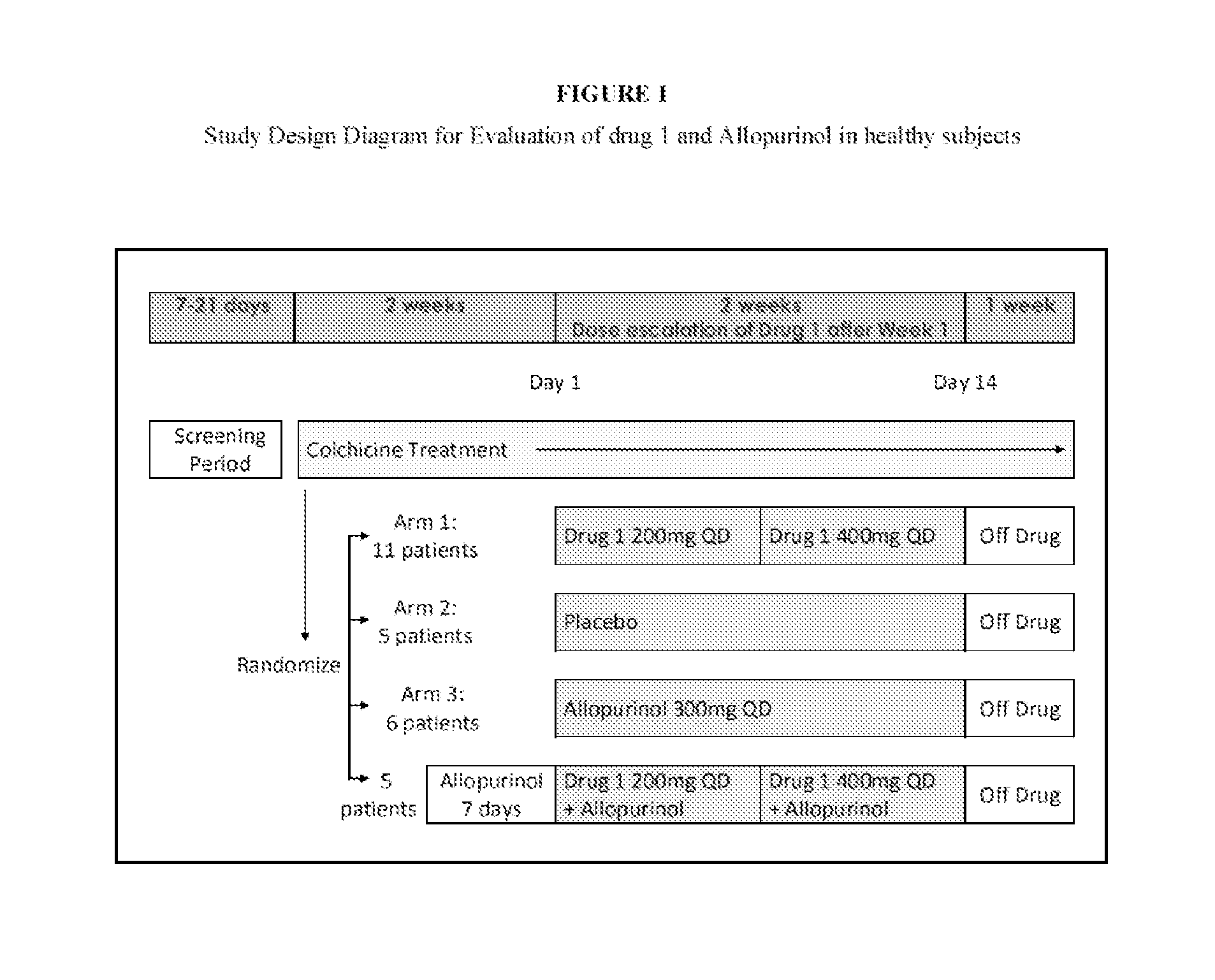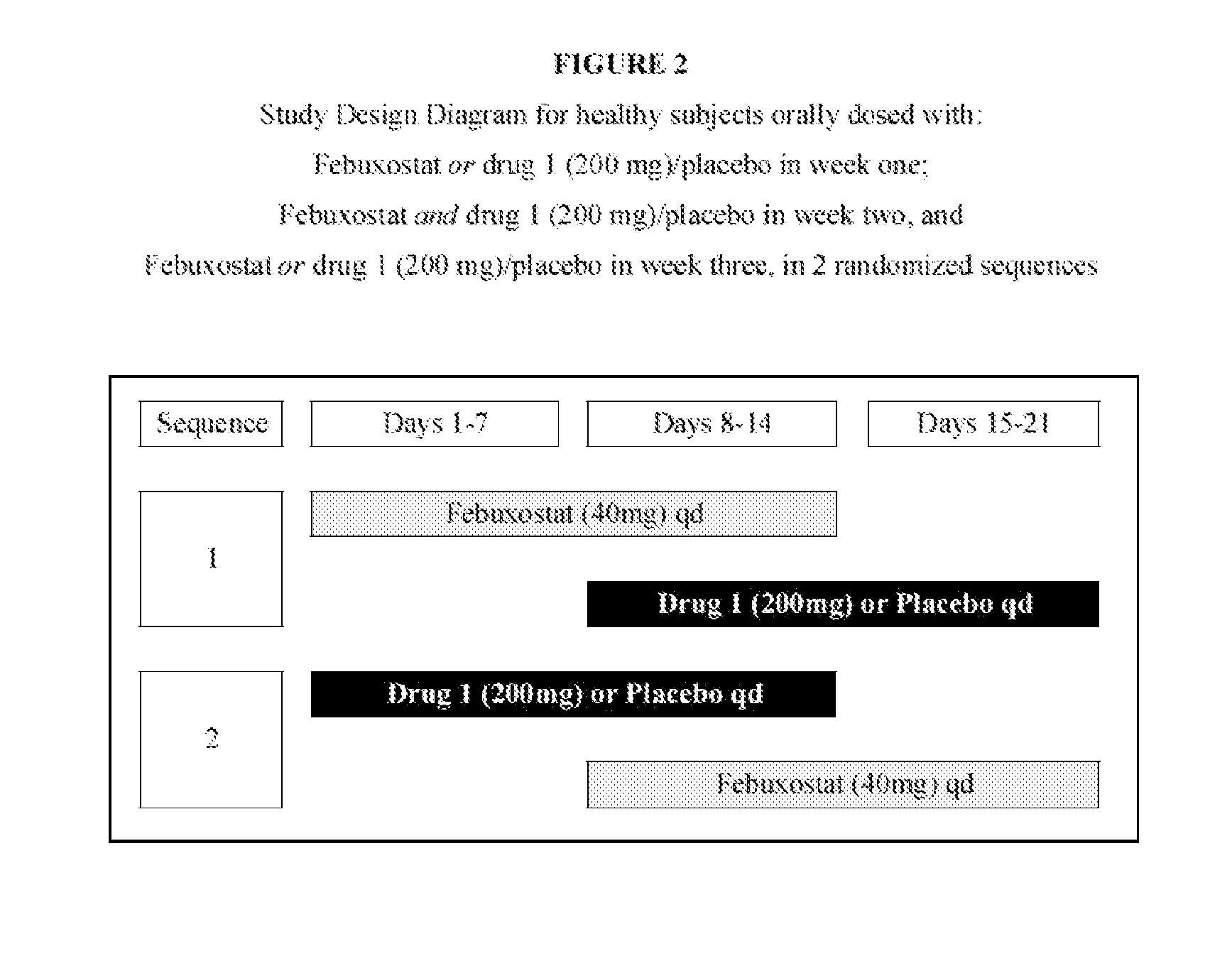Methods for treating hyperuricemia and related diseases
a hyperuricemia and related disease technology, applied in the field of methods for treating hyperuricemia and related diseases, to achieve the effect of reducing the level of serum uric acid
- Summary
- Abstract
- Description
- Claims
- Application Information
AI Technical Summary
Benefits of technology
Problems solved by technology
Method used
Image
Examples
example 1
Study Objectives
[0121]To compare the proportion of subjects whose sUA level is [0122]To evaluate the percent reduction from baseline in sUA levels following 2 weeks of continuous treatment with drug 1 in combination with allopurinol.[0123]To evaluate the proportion of subjects whose sUA levels are [0124]To evaluate the absolute and percent reduction from baseline in sUA levels at each visit.[0125]To evaluate the maximum percent reduction in sUA levels from baseline during the entire treatment period.[0126]To evaluate percent change in 24-hour urine uric acid level from baseline to Day 15.[0127]To evaluate the safety and tolerability of drug 1 in subjects with gout.[0128]To evaluate the pharmacokinetics, safety and tolerability of drug 1 in combination with allopurinol in subjects with gout.
Study Details
[0129]A randomized, double-blind, placebo-controlled, dose titration, safety and pharmacodynamics pilot study, in approximately 26 hyperuricemic subjects with symptomatic gout enrolle...
example 2
[0272]Drug 1 was tested according to the clinical trial protocol described in example 1. Actual enrollment was as follows:
Cohort 1: 21 subjects −11 randomized to Drug 1[0273]−5 randomized to placebo[0274]−5 randomized to open-label allopurinol
Cohort 2: 6 subjects −5 randomized to Drug 1+allopurinol[0275]−1 to placebo+allopurinol
Preliminary Safety Summary (Cohort 1 Only)
[0276]Drug 1 was well tolerated in this study, with no SAEs, deaths or discontinuations due to adverse events and no clinically significant changes in physical exam findings or vital signs. No clinically significant ECG findings including interval measurements, and no dose-related increase in adverse events (all events were transient and mild to moderate in severity).
[0277]Two patients had >30% increase in serum creatinine (SCr) while on 400 mg QD (Grade 1 AE) with no associated increase in BUN levels and no significant abnormality in urinalysis; SCr quickly fell back to normal limits after patients finished the study...
example 3
[0279]Drug 1 is evaluated according to the clinical trial protocol described in example 1, using BCX4208 (is 7-(((3R,4R)-3-hydroxy-4-(hydroxymethyl)pyrrolidin-1-yl)methyl)-3H-pyrrolo[3,2-d]pyrimidin-4(5H)-one) in place of allopurinol.
PUM
| Property | Measurement | Unit |
|---|---|---|
| solubility | aaaaa | aaaaa |
| time | aaaaa | aaaaa |
| volume | aaaaa | aaaaa |
Abstract
Description
Claims
Application Information
 Login to View More
Login to View More - R&D
- Intellectual Property
- Life Sciences
- Materials
- Tech Scout
- Unparalleled Data Quality
- Higher Quality Content
- 60% Fewer Hallucinations
Browse by: Latest US Patents, China's latest patents, Technical Efficacy Thesaurus, Application Domain, Technology Topic, Popular Technical Reports.
© 2025 PatSnap. All rights reserved.Legal|Privacy policy|Modern Slavery Act Transparency Statement|Sitemap|About US| Contact US: help@patsnap.com



